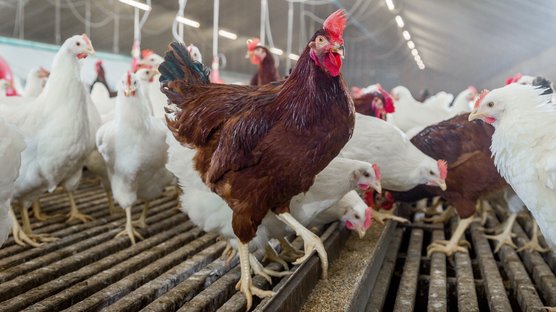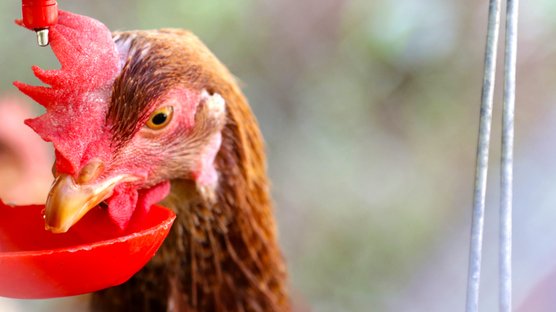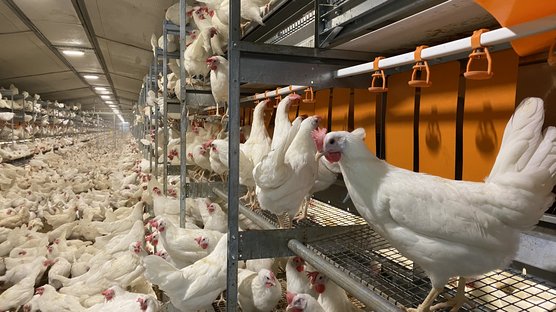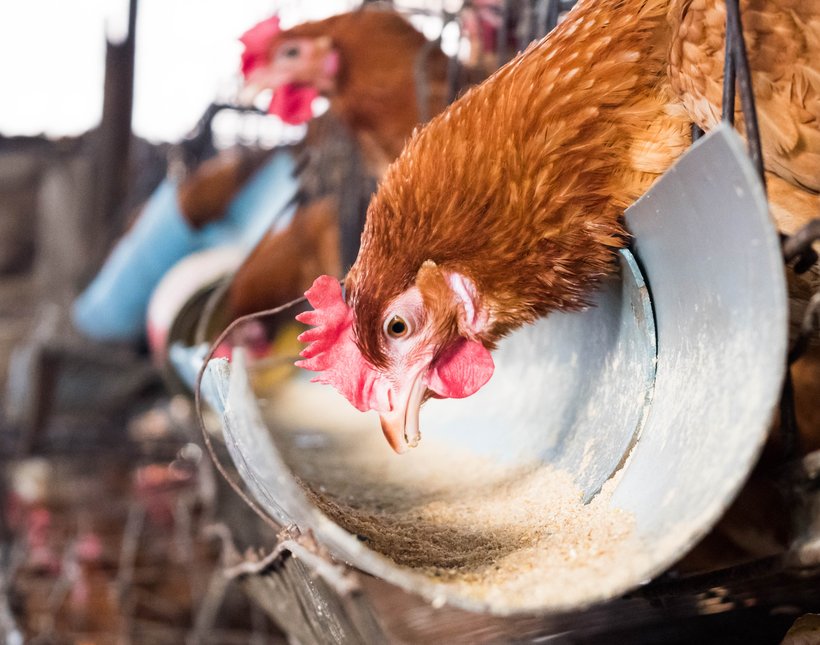
Published on July 1, 2020
Feed strategies to keep your birds productive all the way up to 100 weeks of age
Over the last 20 years, large improvements in the performance of laying hen flocks have been seen. Production cycles have increased all the way up to even 100 weeks of age, combined with increases in the peak of egg production and improved livability this has resulted in higher number of eggs per hen housed. The birds have also become more efficient, which resulted in decrease in the feed consumed per egg produced has decreased by more than 10%.
This massive improvement is only possible if the environment of the laying hens is optimal, as the final performance is an interaction between the birds genetics and their environment. Genetic progress and longer production cycles have direct consequences for nutrition. In order to get the full genetic potential out of your flock it is important to supply the right daily nutrients at the right time.
When laying hens are kept in production for 100 weeks instead of 60 or 80 weeks, the eggs output and their associated export of nutrients, like calcium, are much higher. As egg mass is increased so much, also the birds’ yolk and egg shell formation is increased enormously. High performing birds need a perfect feeding strategy to maintain the desired performance levels. This paper looks at the factors that should be taken into account when designing a feeding strategy to achieve the full genetic potential out of your birds.
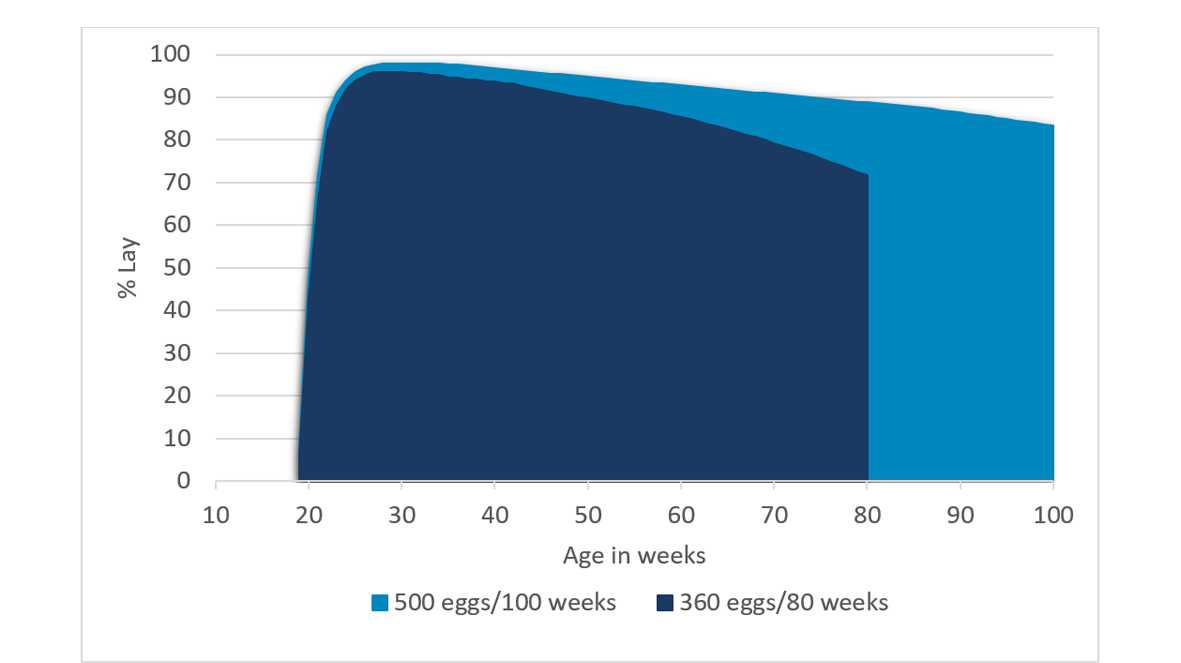
The birds nutrient intake should be balanced with her nutrient requirements
The actual daily nutrient intake is a result of the diet composition (feed formulation) and the daily feed intake level (feed consumption). The actual nutrient intake should match the daily nutrient requirements in all stages of birds’ development: growth, daily maintenance, and/or production. Nutrient requirement is also influenced by the daily egg mass produced, which is a result of egg weight and the number of eggs produced.
In the period of 18 to 35 weeks of age, the birds are still growing and therefore they need nutrients for growth next to their standard needs for maintenance. Besides, as birds come into production in this period, nutrients are required for egg production as well. Depending on the quality of rearing and the training of the feed intake capacity, feed intake is often limited between 18 and 25 weeks of age and might not cover the total nutritional requirement at that stage. If this happens, your hens will start to lose body weight and they will compensate for the negative balance by lowering their production performance during her complete production cycle. For example, they will lower their production in terms of lower laying rate and smaller egg weights, mortality might be increased, and eggshell quality reduced, resulting in an higher number of second grade eggs.
A nutrient deficiency can also occur when daily feed intake is low due to environmental stressors, like heat stress, change in feeds or disease. In these situations an additional midnight feeding can be offered to the birds in order to increase daily feed intake. Besides daily feed intake, water intake is also important. If birds don’t drink, they will not eat as well. Therefore check the water quality and the water intake regularly.
Amino acid profile and level
In general, three different stages and their ideal corresponding amino acid profiles can be distinguished: growth, growth combined with egg production, and egg production. Although all essential amino acids could be the limiting factor, it is lysine which is most commonly seen as being the limiting factor for growth, while methionine is commonly limiting for the production of eggs.
At start of production it is important to provide a diet with sufficient levels of the essential amino acids available. After reaching the correct egg size and adult body weight (approximately 30-35 weeks of age), the hens should be able to cope with a lower concentration of amino acids. Nevertheless, amino acid levels for birds in production should always be determined based on the daily egg mass produced (laying rate times egg weight) and never on the age of the birds. Meaning that changing the rations in the diet is based on daily egg mass produced and not on age!
Importance of the uniformity of the flock
Because of differences between birds in performance, nutritional requirements must take the uniformity of the flock into account. The feeding strategy should allow the weakest birds to further develop while allowing the best birds to produce at their genetic potential. This can be achieved by respecting a safety margin for the inclusion of digestible amino acids, particularly in a situation where uniformity is rather low. If levels of digestible amino acids are set above the theoretical concentration (+6%) excellent results can be achieved. For example, birds within the same flock but at different production performance levels will consequently show variety in their requirements for methionine. Please keep in mind, it is important to keep your flock as uniform as possible! For brown egg layers a uniformity of at least 85% should be targeted, and for white egg layers a uniformity of 90%.
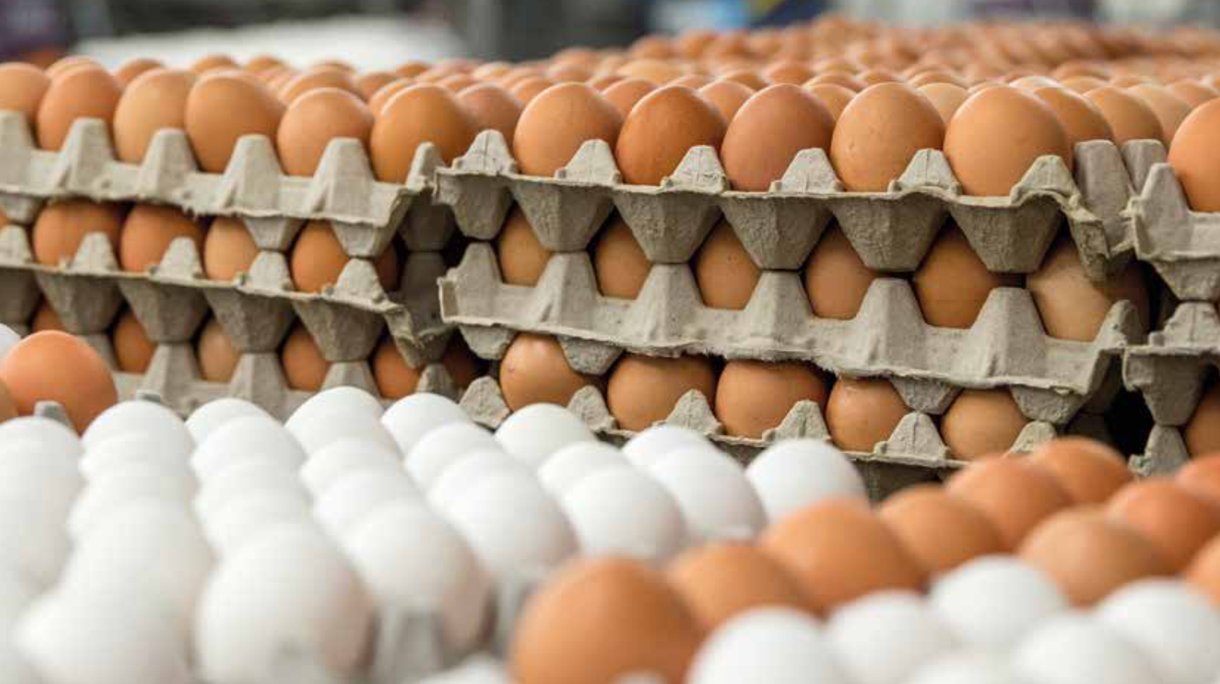
Changing energy level related to feed intake and body weight
Energy requirements are determined by the bird’s maintenance (like temperature regulation and the daily activity levels), egg production, and growth. The energy consumption is determined by feed composition, feed presentation, and feed management. There is a direct relation between feed consumption and metabolizable energy intake, as laying hens are partly able to adjust their feed consumption according to the energy concentration in the diet. However, this regulation mechanism is not perfect and a higher concentration of metabolizable energy leads to a higher energy intake even though the daily feed consumption is reduced due to an increase in metabolizable energy concentration.
As with all other nutrients, the energy intake is rather challenging around the onset of lay. At the onset of lay, the birds feed intake capacity is still low, whilst the daily requirements are high because the birds are still growing and they have already started with the production of eggs. Therefore, the priority at the onset of lay is to reach adult body weight in order to obtain high and good persistency and the desired egg weight profile during the production cycle. To achieve this, a feed high in metabolizable energy is needed, this diet at the start of lay should be at least higher in energy compared with the diets provided at the end or rearing or later on in the laying cycle. If birds still struggle with gaining enough body weight at start of lay, energy content could be increased by an additional 50 to 100Kcal/kg. After the birds have reached their adult body weights, reached the proper level of daily feed intake and the targeted egg weight, energy levels can be lowered towards the end of the cycle.
The main objective of feeding adult birds all the way up to the end of the cycle, is to avoid birds from getting fat. The prevention of fat birds can be achieved by lowering energy levels and controlling energy intake. This can be achieved by reducing the levels of added fat or oil and increasing the amount of fiber in the diet
Fiber for livability
The presence of insoluble fiber, like oat hulls, appears to be essential. An appropriate supply of fibers results in a good feather cover, improved livability, good intestinal health, proper digestion (of mainly starch) and better manure quality (drier). Livability is positively influenced by fibers as it increases the feeling of satiety in birds, which in turn results in quieter birds and eliminating their need for feather ingestion (pecking and cannibalism). Fiber also helps to increase the gizzard size and therefore it improves the nutrient digestibility. Diluting the feed with fibers helps to maintain a good energy balance in older birds and to prevent fatty livers.
Birds also have a specific requirement for fiber during egg production. They must find fiber in the feed or in their immediate environment. It has been shown that birds that are deficient in fiber ingest feathers as a fiber source. Feathers may be taken from the floor or pecked from other birds. Monitor feather presence on the floor and if no feathers are found, check out some gizzards for the presence of feathers. This is a valuable tool to identify the origin of feather pecking behavior in a flock.
Keep the liver healthy, as it is a key organ for egg production
The liver is one of the key organs, essential to function properly in birds kept in a long production cycle. The liver plays a key role in egg production, egg weight profiles, laying rate, persistency in lay, egg shell formation, livability, and feed conversion. The older the birds become, the more egg mass they have produced. Therefor the more challenging it will be to maintain a healthy liver. A fatty liver is in malfunction and will consequently lead to reduced production performance or a higher percentage second grade eggs. The main challenge is the omnipresent risk of developing a fatty liver, as predisposing factors are frequently present in current commercial egg production circumstances. The energy source has an effect on liver health, as lipoprotein formation from lipids (fat) is efficient and easy for the liver, while energy from proteins and carbohydrates/starch is more challenging. Therefore, replacing part of the carbohydrates by fat or oil will help to keep the liver healthy. Other factors that might result in the risk of fatty livers are high temperatures, high energy intake, fat birds and cage housing systems (less activity).
With nutrition it is possible to stimulate the recovery of the liver. As mentioned above, replacing part of the carbohydrates by fat or oil and providing the ability for activity will help to reduce fat accumulation on the liver. Within the vitamin range, choline or betaine, vitamin B12, folic acid and vitamin E are important. Choline is highly effective and present in a wide variety of raw materials, although the availability of choline in raw materials can fluctuate. Supplementary choline or betaine is always beneficial for the birds in production and therefore must be included in layer diets. Choline and betaine have several functions, but specifically related to the topic of fatty livers: they are working lipotropic by preventing fat accumulation by increasing the fatty acid utilization in the liver and by promoting the transport of lecithin. There are multiple factors that determine the amount of added choline or betaine: raw material selected, the length of the production period, the birds health status and the desired safety margins as part of risk management. In situations of increased incidence of fatty livers, start increasing the choline or betaine supplementation from 18 weeks of age onwards. The advised added choline levels in the layer feed are 500-1000ppm, with 250ppm as an absolute minimum.
The importance of calcium and phosphorus
The first half of the rearing period is the most important period for preparing the bird for the laying period. Skeletal development is finished for almost 95% at an age of 11 weeks. During this period, the levels of calcium and phosphorus and their ratio are important to help the chicks in developing a robust frame. Just before the onset of lay, the calcium need is increasing for both medullary bone formation and the production of the first eggshells. If is advised to feed a pre-layer diet starting at 14 to 10 days before expecting the first egg till 2% of lay. This will help to meet the calcium requirements for medullary bone formation and the first egg shell production, and to have a smoother transfer from a low calcium diet (developer diet) to a high calcium diet (layer diet). If the calcium level is not sufficient for eggshell production, it will result in decalcification and transport from calcium from the bones towards the eggshell. In order to obtain robust medullary bone, and therefore better eggshell during the full laying cycle, decalcification should be prevented.
During egg production the calcium source is important, especially towards the end of the cycle. The eggshell is mainly formed during the dark period, when the birds are asleep and are not actively consuming feed during. Therefore, the calcium source should be coarse (2-4mm) and slowly soluble to extend the period of calcium absorption from the feed in the intestinal tract and thereby lower the level of decalcification from bones. Making sure that most of the calcium used for eggshell formation is from the feed and not from the bones, will improve egg shell quality, especially towards the end of the laying cycle.
A correct feed composition requires correct feed management
A correct feed composition requires the correct feed management, to make sure the required nutrients are available at the correct timing. Although calcium requirements will not be dramatically different for birds in longer production cycles, adaptations in management by adjusting the feeding technique have been shown to be beneficial. For maintaining good eggshell quality, the feeding technique seems to be more important than the actual nutrition, especially in birds at the end of a longer production cycle.
One feeding technique beneficial for eggshell quality, is providing the nutrient in line with the cycle of egg formation. During the morning, there is a higher requirement for energy, protein, phosphorus for yolk formation and replacement of the medullary bone. While the afternoon requires mainly calcium for eggshell formation during the night. If farm management allows you to do so, you can help the birds supplying the right nutrients at the right time. By either providing to different types of feed, so called split-feeding, or by providing extra and coarse calcium at the end of the afternoon. This will maximize the use of calcium from the feed, while minimizing the mobilization of calcium from the bones.
An additional method is to apply the empty feeding technique. It is important to make sure feeders are empty at the middle of the day (for 1.0-1.5 hours), in order to increase feed consumed at the end of the day. The morning feed is around 40% of the daily feed intake. The afternoon feed, which is about 60% of the amount of feed consumed on a daily bases, can be fed from 6 or 7 hours before light off moment onwards.
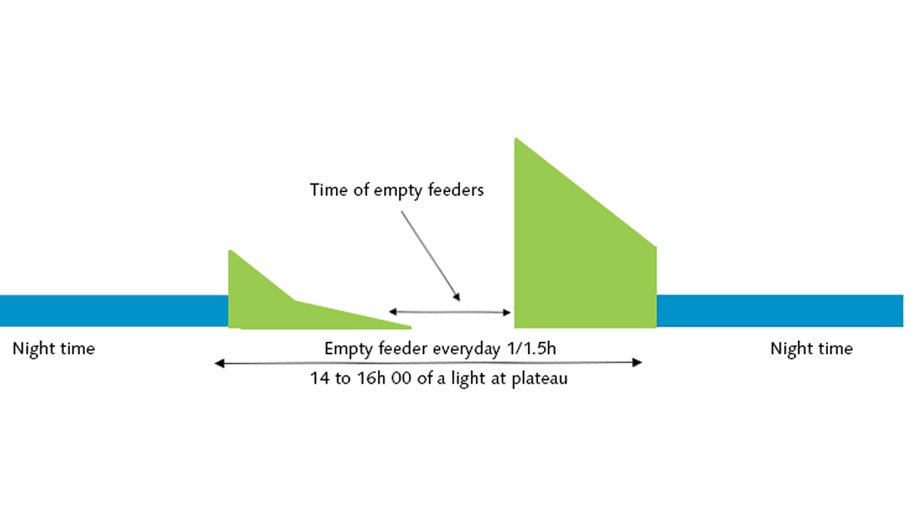
In summary
To conclude, provide enough amino acids (take daily egg mass and actual feed intake into account), keep a close eye on the uniformity of the flock and provide amino acids above the theoretical requirements in order to achieve excellent results. Control the birds’ energy balance by respecting the amount of energy needed for growth, performance and maintenance. For proper dietary energy management, frequent monitoring of feed intake and body weights is essential. Furthermore, lower the energy levels towards the end of the production cycle and control feed consumption by adding insoluble fibers to the diet in order to be successful in a longer production cycle all the way up to 100 weeks. Have a focus on liver health, try to prevent the development of a fatty liver by providing energy from fat instead of energy from carbohydrates and by supplementation with sufficient amounts of vitamins to support egg and eggshell production. And not to forget, make sure that the calcium supply is at the correct level especially at the end of the rearing period (pre-layer diet) to minimize bone decalcification as much as possible in order to achieve a robust medullary bone. For prolonged cycles of egg production, the moment of nutrients available is crucial for maintaining performance! Therefore, make sure that calcium is available at the moment of calcification by providing the sufficient amount of coarse and slowly dissolving calcium during egg production.

